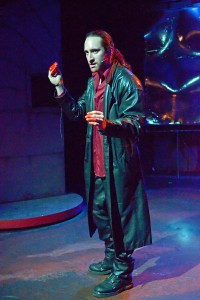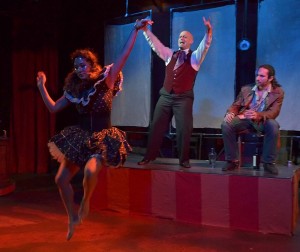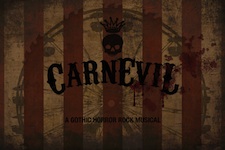FAUSTIAN PHANTASMAGORIA
“There is nothing new under the sun,” said a Jewish writer more than two thousand years ago. While such a sentiment may not have been intended to discourage creativity, it can’t help but betray a certain weariness with the world. And such seems to be the present mood in Hollywood, where the big studios churn out yet another comic-book adaptation, remake another 70s television show, or re-release The Lion King in a 3D version. A further symptom of this malaise is the mixing of genres or character franchises: Aliens vs. Predators, King Kong vs. Godzilla and Cowboys and Aliens. Why take a risk on something more original, yet unknown, when you can adapt or remake something that already has brand recognition? Sadly, such is the way many studio heads think.
 Theater companies are often even more conservative in their programming, putting on yet another Shakespeare or Tennessee Williams play. They like to mix genres too, particularly if they have a devoted following of twenty- and thirty-somethings, as does Sacred Fools on the southern edge of Hollywood. Sacred Fools is currently running a show called CarnEvil: A Gothic Horror Rock Musical. With such a convoluted subtitle, it is difficult to take CarnEvil very seriously – and we probably should not. And this is one of the tensions at the heart of the production: is the audience meant to laugh or not? Is this all horribly serious or absolutely tongue in cheek? Perhaps it is both; there are no simple solutions. Some scenes are completely campy homages to recent horror films like Saw and Hostel, with a bit of Frankenstein thrown in. Other aspects of the play are rather serious, such as the family drama at its center and the struggle between good and evil. One could perhaps best describe this as The Imaginarium of Dr Parnassus meets Sweeney Todd.
Theater companies are often even more conservative in their programming, putting on yet another Shakespeare or Tennessee Williams play. They like to mix genres too, particularly if they have a devoted following of twenty- and thirty-somethings, as does Sacred Fools on the southern edge of Hollywood. Sacred Fools is currently running a show called CarnEvil: A Gothic Horror Rock Musical. With such a convoluted subtitle, it is difficult to take CarnEvil very seriously – and we probably should not. And this is one of the tensions at the heart of the production: is the audience meant to laugh or not? Is this all horribly serious or absolutely tongue in cheek? Perhaps it is both; there are no simple solutions. Some scenes are completely campy homages to recent horror films like Saw and Hostel, with a bit of Frankenstein thrown in. Other aspects of the play are rather serious, such as the family drama at its center and the struggle between good and evil. One could perhaps best describe this as The Imaginarium of Dr Parnassus meets Sweeney Todd.
At its most basic, CarnEvil is the story of a family-run carnival struggling to make enough money to survive. It’s full of eccentric characters like Albert (David Haverty), the resident freak whose body is completely covered in hair, and bonehead Jerry (Geoffrey Dwyer), a kind-hearted crocodile-wrestler. But there are plenty of other more typical characters who simply dance across the stage in skimpy costumes without saying a word. Then Danny (James Lynch), the black sheep of the family, returns looking for a place to stay – temporarily, he claims. With his long hair, bad boy attire, and dark secret, Danny begins to stir up trouble. We get the impression that Danny wants to be good, but his past won’t leave him in peace. What is it that troubles him? We get an glimpse of what Danny is capable of when he brings Jerry’s crocodile back to life. Danny has a power that he is afraid to use. It’s a bit like Frodo and the ring in The Lord of the Rings. To use the power is to be controlled by it, to become its slave.
When a mysterious stranger, Craven Moon (Jeff Sumner), meets Danny one evening and offers to become a part of his circus, Danny soon throws caution to the wind. Craven knows about Danny’s power and seeks to unleash it so that he can control Danny. Craven is a puppet master by trade, one who controls dancing marionettes without the aid of strings. Together Danny and Craven transform the carnival from family-friendly entertainment into something evil and sinister. Craven and company begin to kill off both carnival-goers and cast members, who suffer horrifying deaths. But they don’t just die and disappear. Craven turns them into marionettes, thereby taking over the carnival and making it his own evil carnival.
 In this twisted tale, Craven plays the devil to Danny’s Dr. Faust. Danny doesn’t exactly sell his soul to the devil, but he does allow himself to become enslaved by the dark power that is in him. Why? Because it is the only way to keep the carnival going. Danny is sacrificing himself for the continuance of his family’s carnival. Danny struggles and we see his inner turmoil, but we have no sympathy for him. James Lynch plays Danny competently enough, but he lacks charisma. He seems to be just another bad boy making bad choices. Craven, despite his sinister persona, seduces his victims with the glamour of evil. He is supported in this by seductive sidekicks like Mina (Whitney Avalon) and Tina (Liza Baron), two incestuous Lesbian Siamese twins attached at the hip. Craven makes Danny’s carnival a success, not by virtue of his evil ways, but by virtue of his visionary charisma. He is the leader that Danny could never be; nor could Abner (Joey Bybee) before him.
In this twisted tale, Craven plays the devil to Danny’s Dr. Faust. Danny doesn’t exactly sell his soul to the devil, but he does allow himself to become enslaved by the dark power that is in him. Why? Because it is the only way to keep the carnival going. Danny is sacrificing himself for the continuance of his family’s carnival. Danny struggles and we see his inner turmoil, but we have no sympathy for him. James Lynch plays Danny competently enough, but he lacks charisma. He seems to be just another bad boy making bad choices. Craven, despite his sinister persona, seduces his victims with the glamour of evil. He is supported in this by seductive sidekicks like Mina (Whitney Avalon) and Tina (Liza Baron), two incestuous Lesbian Siamese twins attached at the hip. Craven makes Danny’s carnival a success, not by virtue of his evil ways, but by virtue of his visionary charisma. He is the leader that Danny could never be; nor could Abner (Joey Bybee) before him.
CarnEvil may be about a carnival gone bad, but what is less obvious in the title is the carnal part, from the Latin caro, meaning flesh. Like many productions at Sacred Fools, CarnEvil is full of sex and violence. Sex and violence sells; it fills seats. Yet, the sex and violence obscures the real drama of CarnEvil, which is one man’s inner struggle, not merely a struggle between good and evil in his soul, but a struggle to stay to true to himself rather than sell out for the sake of success. This struggle threatens to tear his soul apart. Instead, the audience sees bodies torn apart. There’s an astounding lack of subtlety. To suggest that the literal rending of bodies is a metaphor for the rending of the soul would be to suggest greater depths of meaning than this gothic horror rock musical is capable of. All one can reasonably expect of CarnEvil is to be entertained by over-the-top rock diva-style singing and mediocre special effects, to be distracted by constant set changes and to be seduced by the glamour of evil.
barnaby @ stageandcinema.com
CarnEvil: A Gothic Horror Rock Musical
Sacred Fools Theatre
scheduled to end on October 29
for tickets, visit http://www.sacredfools.org/

{ 1 comment… read it below or add one }
Dear Barnaby,
My sentiments as well…..it is a play with characters in search of the plot.
However, there are artful moments rather than “special effects”…..and I
point to the beautiful shadow puppetry design which was on screen a bit….
a scene with figures moving in a circular “coven ritual” fashion. Who knows
shadow puppetry, not many; it can be mistaken for slides? Moments like
that, in addition to more use and better lighting of the monster “shogoth” could have added to the visual aesthetic. (The puppets seemed to be used incidentally.) You named the real struggle thoughtfully.